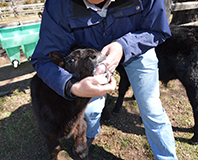Read the latest information on
Foot-and-mouth disease
 Zoonotic diseases are those that can be transmitted from animals to humans. People that live and work around livestock or wildlife are at greater risk of contracting a zoonotic disease, but anyone in close proximity to any animals should make sure they are zoonosis aware. These diseases have the potential to cause serious long-term health implications for those who contract them.
Zoonotic diseases are those that can be transmitted from animals to humans. People that live and work around livestock or wildlife are at greater risk of contracting a zoonotic disease, but anyone in close proximity to any animals should make sure they are zoonosis aware. These diseases have the potential to cause serious long-term health implications for those who contract them.
In Australia we have a range of these diseases, ranging from mild conditions such as ringworm, through to more serious diseases such as Q fever or Hendra virus, which can be fatal to those who contract it. Through simple prevention strategies, the risks of these diseases can be significantly reduced.
“In 2014, I was unfortunate enough to get leptospirosis – a bacterial disease that can infect many species of animals, including humans,” said Jess Rummery, AHA’s Biosecurity and Extension Manager for Northern Australia.
“Overnight, I went from healthy to being so sick that I was unable to work or even leave the house.”
There have been over 120 notifications of leptospirosis in Australia so far in 2018, as well as a further 300 notifications for Q fever.
“It is likely that these cases are just the tip of the iceberg and that many cases of these diseases in Australia go undiagnosed,” Jess explained.
These diseases can be spread in a number of ways, including through direct contact with infected animals, inhalation, by ingestion or through vectors (for example mosquitoes). Prevention should be targeted towards minimising these pathways of infection.
Jess explained that greater awareness and understanding of zoonotic diseases can help prevent infection, and also aid in a timely and accurate diagnosis when infection does occur.
“My symptoms were so non-specific that it took months before I finally got any answers and since then it has been a very long road to recovery,” Jess said.
“I often wonder, if my infection had been picked up earlier, would I have experienced the severity and length of illness that I have struggled with over the past four years?
“If by raising awareness within our agricultural communities we can even prevent one case like mine, I would call that a success. I encourage everyone living or working around livestock, wildlife or other animals to be zoonosis aware, starting with a few simple steps [below].”
Seek urgent medical attention for all suspicious signs of disease – if you live or work with livestock or wildlife you should inform your doctor so they can check for zoonotic diseases. Further information can be found on your state or territory agricultural or government health websites.